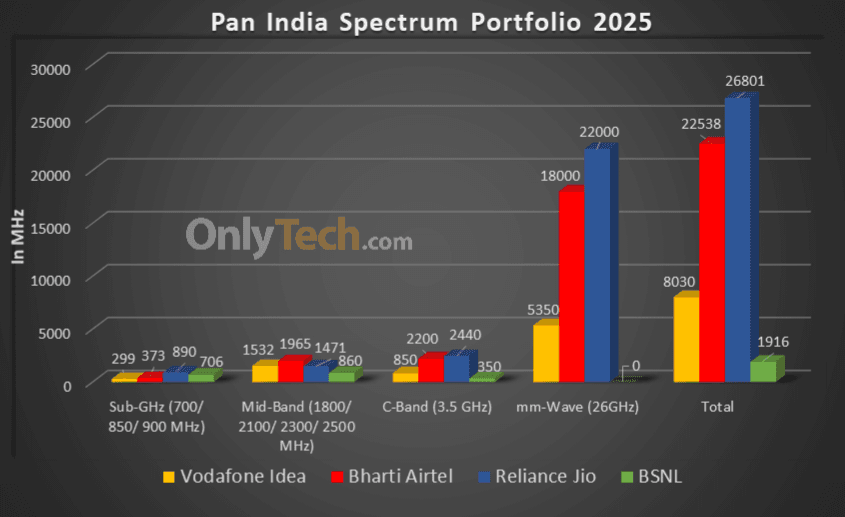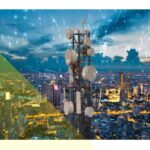Spectrum is for telecommunication what jet fuel is for aviation. Spectrum is a range of electromagnetic frequencies or airwaves that telecom companies use for establishing a connection between a cell tower and a mobile phone. The bandwidth of this spectrum is directly proportional to the speed of a wireless data network (since more data can be transmitted simultaneously through a broader data pipeline). In contrast, the frequency is inversely proportional to the coverage (since lower frequencies penetrate better through physical barriers and thus have wider coverage).
The spectrum holding data sheet embedded in this article represents the current spectrum holdings of all active telecom operators across all frequency bands across all 22 telecom circles along with their liberalisation status and expiry dates. All figures represented are in MHz. The value mentioned in the bracket beside the frequency at the base of each sheet is the band number where ‘B’ stands for 4G LTE band whereas ‘n’ stands for the corresponding 5G NR band.
The spectrum shown under BSNL and Aircel in white is reserved for the respective operators but has not yet been officially allotted to them.
Spectrum Liberalisation:
Spectrum was administratively allocated to operators in each of the 22 licensed service areas or circles prior to 2010, this spectrum is called non-liberalised and can only be used for 2G services whereas all airwaves allotted post-2010 have been through a Spectrum Auction where operators have paid the market discovered price and this spectrum is called liberalised and can be used for any technology platform 2G/3G/4G/5G. Alternatively, operators may choose to liberalise their administratively allotted spectrum by paying the market-discovered price to DoT on a pro-rata basis for the remaining validity of the spectrum.
Paired and Unpaired spectrum:
Spectrum may be paired or unpaired, bands 1/3/5/8/28 are all paired where one set of frequencies is used for uplink whereas another distinct set of frequencies is used for downlink known as Frequency-division duplexing (FDD), whereas bands 40/41/78/258 are unpaired where both uplink and downlink happens in the same set of frequencies separated by the time of uplink and downlink known as Time-division duplexing (TDD).
List of Indian FDD Bands:
| 4G LTE band | 5G NR band | Uplink frequency range (MHz) | Downlink frequency range (MHz) | Bandwidth for telecom (MHz) | Block size (MHz) |
|---|---|---|---|---|---|
| B1 | n1 | 1939-1979 | 2129-2169 | 40×2 | 5×2 |
| B3 | n3 | 1710-1780 | 1805-1875 | 70×2 | 0.2×2 |
| B5 | n5 | 824-844 | 869-889 | 20×2 | 1.25×2 |
| B8 | n8 | 890-915 | 935-960 | 25×2 | 0.2×2 |
| B28 | n28 | 723-733/ 738-748 | 778-788/ 793-803 | 20×2 | 5×2 |
List of Indian TDD Bands:
| 4G LTE band | 5G NR band | Frequency range (MHz) | Bandwidth for telecom (MHz) | Block size (MHz) |
|---|---|---|---|---|
| B40 | n40 | 2300-2380 | 80 | 10 |
| B41 | n41 | 2535-2555/ 2615-2655 | 60 | 10 |
| – | n78 | 3300-3670 | 370 | 10 |
| – | n258 | 24250-27500 | 3250 | 50 |
Spectrum caps:
A spectrum cap dictates how much spectrum a particular operator can hold in a circle for a specific band. There is a 40% cap for Sub-GHz spectrum in the 700/850/900 MHz bands combined, a 40% cap for Mid-Band spectrum in the 1800/2100/2300/2500 MHz bands combined, a 40% cap for the C-Band spectrum of 3300-3670 MHz and a 40% cap for the mm-Wave spectrum bands of 24.25-27.5 GHz. The current spectrum caps are denoted in the spectrum chart.
Overall spectrum holdings of operators (in MHz):
| Operator/Holding | Jio | Airtel | Vi | BSNL |
|---|---|---|---|---|
| Sub-GHz | 890 | 373.2 | 298.8 | 706 |
| Mid Band | 1470.8 | 1964.9 | 1531.6 | 860 |
| C-Band | 2440 | 2200 | 850 | 350 |
| mm-Wave Band | 22000 | 18000 | 5350 | 0 |
| Total | 26,800.8 | 22,538.1 | 8,030.4 | 1,916 |
Spectrum sharing/trading/leasing guidelines:
- Telecom operators holding CMTS/UASL/UL licenses can enter into a Spectrum-Sharing agreement with each other so long as both parties hold liberalised spectrum in the same band in the same circle. Spectrum sharing is possible only on a Pan LSA level in block sizes defined by DoT and only after one year of an operator acquiring the spectrum.
- Telecom operators holding CMTS/UASL/UL licenses can enter into a Spectrum-Trading agreement with each other so long as the spectrum being sold is liberalised. Trading of spectrum is possible only on a Pan LSA level in block sizes defined by DoT and only after two years of an operator acquiring the spectrum.
- Telecom operators may enter into a Spectrum-Leasing agreement only with Enterprises holding a Captive Non-Public Network (CNPN) license and not with each other. The lease may be limited to any geographic area within the LSA and for any duration mutually agreed upon by both parties. A CNPN licensee can lease spectrum from multiple operators within an LSA.
Note: We update this chart in real-time to ensure it is always up to date with the latest changes in spectrum holding. Certain human errors might have crept in during the manual compilation of the data, any mistakes/ rectification can be brought to the Team’s notice through the comments section below.








@esmail what is the difference in ” revenue sharing model ” pre 2010 and post 2010 between telcos and government ?
Before 2010 the operators used to get spectrum bundled along with the telecom licence for a circle and they had to pay a spectrum usage charge (SUC) to the government, proportional to their adjusted gross revenue (AGR). After 2010 the DoT decoupled Licence and spectrum, such that the operators pay separately for licence which doesn’t include any bundled spectrum and buy the spectrum through an open auction at the market determined price. In this scenario though SUC becomes redundant, which is why the government is abolishing it from the next auction onwards.
@esmail how will BSNL get benefited by merger with BBNL ?
We have an article about this news, you can ask this question in that article’s comments section. We are trying to keep the Spectrum chart’s comments section clean and focused on spectrum related discussions.
How much spectrum available in 2500Mhz in India? T-Mobile hold 160Mhz in 2500Mhz currently and it has deployed 100Mhz in Texas from 160Mhz and speeds easily cross 400Mbps on peak times. Will it available in these quantities in India in future auctions? or Any other band from 2000Mhz category?mm-wave makes no sense as it doesn’t provide range inside the home. People in India already opposing use of 600Mhz for 5G and only 30Mhz in 700Mhz isn’t sufficient. Even in this case,BSNL needs to die for Vi to deploy 15-20Mhz in each circle for 4G/5G. What’s your thought? Any band lower than 600Mhz for 5G?
Only 40 MHz is available as of now in 2500 MHz band the remaining spectrum is with department of space and only if they release it can it be used for telecom. As of now IMT has only identified the 600 MHz band, there is spectrum available below that as well but the band hasn’t been standardized yet. 600 MHz though will be used by telcos if it is priced correctly.
remaining spectrum is with department of space.
How much amount? That’s what I want to know exactly.
154 MHz 🙂
So total 154+40= 194?
I just wish DoS releases and DoT uses it for telecom purposes.
Yes
How much in band 1 like this in total?
40 MHz is the total Available in band 1 for telecom usage in India.
Apart from that, the way you mentioned 194Mhz for band 41?
@esmail : How much spectrum available in 500Mhz band which Airtel has DoT to auction? For telecom purpose?
Currently ITU has not identified any band to cater to this spectrum range so it’s a little early to say what the bandwidth available in this region will be. Let’s wait until the 3GPP bands list is updated with the new band info and for DoT to finalise it. In the next auction we may see the 600 MHz band 71 being put up for sale since DoT has finalized 35 MHz bandwidth for it. The 500 MHz band might have to wait until the auction next year.